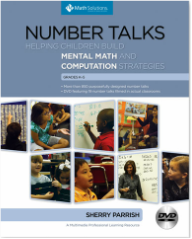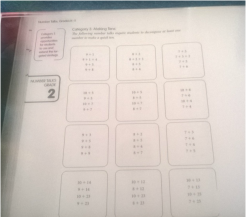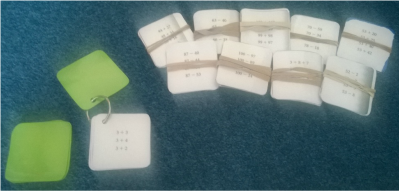
This past year in Primary 1 (kindergarten), I've had dot cards and rekenreks readily available, so number talks have been easy to implement. I've realised, however, that I've done them randomly - I haven't followed the suggested sequences from the book.
I feel like the kids in my class benefited enormously from the number talks, and I was pleased with how their number sense developed over the year. Re-reading the book, however, I can see benefits of following the sequences given in the book - not least because it means I don't have to think on my feet nearly as much!
But it isn't very practical to have the book open next to you while you are teaching, so my daughter and I put our heads together to come up with a better way to approach this.
I feel like the kids in my class benefited enormously from the number talks, and I was pleased with how their number sense developed over the year. Re-reading the book, however, I can see benefits of following the sequences given in the book - not least because it means I don't have to think on my feet nearly as much!
But it isn't very practical to have the book open next to you while you are teaching, so my daughter and I put our heads together to come up with a better way to approach this.

My very kind daughter photocopied all of the pages which give 2nd grade (Primary 3) number talk sequences. Each square you see on the page contains a sequence of 4 different equations which would be given one after another, to help the children focus in on using a given computation strategy.
We enlarged the page from A4 to A3 (not sure what that translates to on American photocopiers), to make the squares slightly larger. This summer, my daughter has been cutting out the cards for me, keeping each group of talks together (each page represents a group of talks). One page might be 1-2 weeks worth of number talks for your class, depending on how quickly they were picking up the strategy you were working on.
What to do next? Well, if you were to wander through my classroom, and have a look at the different resources available for the kids, you would quickly realise that I LOVE scrapbooking rings. So I obviously thought of them again when we were thinking about how to make it easy to sequence number talks effectively in the classroom.
We enlarged the page from A4 to A3 (not sure what that translates to on American photocopiers), to make the squares slightly larger. This summer, my daughter has been cutting out the cards for me, keeping each group of talks together (each page represents a group of talks). One page might be 1-2 weeks worth of number talks for your class, depending on how quickly they were picking up the strategy you were working on.
What to do next? Well, if you were to wander through my classroom, and have a look at the different resources available for the kids, you would quickly realise that I LOVE scrapbooking rings. So I obviously thought of them again when we were thinking about how to make it easy to sequence number talks effectively in the classroom.

Here, you can see the different sets of number talks that my daughter has cut out (all bundled together with rubber bands). Next to the unfinished sets is a set I've put onto a scrapbooking ring - I've ordered the cards in the same order given in the Number Talks book. The green card on the ring is my 'go' card - it lets me know that the following card is the first card in my number talk sequence.
Once these sets are all made up, I'll still have a bit of thinking to do. I suspect I'll need to add handwritten labels to the green card, giving the strategy those number talks are targeting. I'll also probably need to number them, so I have a rough idea of the general order (although I'm not above mixing things up a bit, if that seems like the right thing to do for my class!). Once we're further along in getting these ready for next year, I'll post more pictures and let you see how they've all turned out.
Once these sets are all made up, I'll still have a bit of thinking to do. I suspect I'll need to add handwritten labels to the green card, giving the strategy those number talks are targeting. I'll also probably need to number them, so I have a rough idea of the general order (although I'm not above mixing things up a bit, if that seems like the right thing to do for my class!). Once we're further along in getting these ready for next year, I'll post more pictures and let you see how they've all turned out.

 RSS Feed
RSS Feed